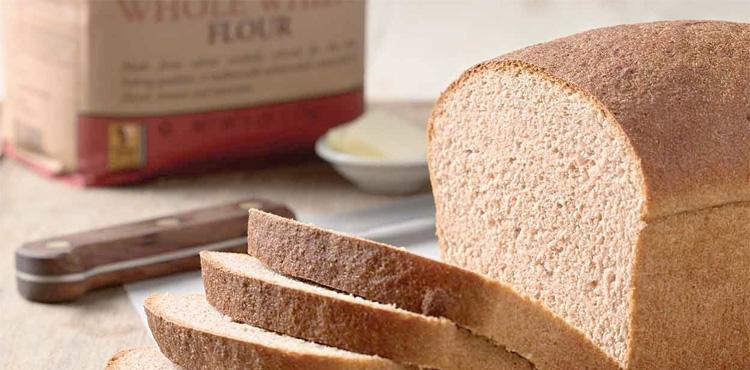Active time
20 minutesTotal time
3 hoursYield
1 loaf, 16 slices.Serving Size
1 slice (51g)Nutrition
Share This
Ingredients
2 ½ teaspoons instant yeast, or 1 packet active dry yeast dissolved in 2 tablespoons water
1 ⅓ cups (10 ½ ounces) water
¼ cup (1 ¾ ounces) vegetable oil
¼ cup (3 ounces) honey, molasses, or maple syrup
3 ½ cups (14 ounces) whole wheat flour
¼ cup (1 ounce) nonfat dried milk
1 ¼ teaspoons salt
Instructions
Mixing:
- In a large bowl, combine all of the ingredients and stir till the dough starts to leave the sides of the bowl.
- Transfer the dough to a lightly greased surface, oil your hands, and knead it for 6 to 8 minutes, or until it begins to become smooth and supple. (You may also knead this dough in an electric mixer or food processor, or in a bread machine programmed for “dough” or “manual.”)
- Transfer the dough to a lightly greased bowl, cover the bowl, and allow the dough to rise till puffy though not necessarily doubled in bulk, about 60 minutes, depending on the warmth of your kitchen.
Shaping:
- Transfer the dough to a lightly oiled work surface, and shape it into an 8-inch log.
- Place the log in a lightly greased 8 ½ x 4 ½-inch loaf pan, cover the pan loosely with lightly greased plastic wrap, and allow the bread to rise for about 1 hour, or until it’s crowned about 1 inch above the edge of the pan. A finger pressed into the dough should leave a mark that rebounds slowly.
Baking:
- Bake the bread in a preheated 350°F oven for about 40 minutes, tenting it lightly with aluminum foil after 20 minutes.
- Test it for doneness by removing it from the pan and thumping it on the bottom (it should sound hollow), or measuring its interior temperature with an instant-read thermometer (it should register 190°F at the center of the loaf).
- Remove the bread from the oven, and cool it on a wire rack before slicing. Store the bread in a plastic bag at room temperature.
Tips:
- Why the range of water in the dough? A lot depends on the weather, the season, and how you measure flour. You’ll need the lesser amount of water in the summer; or when it’s humid/stormy; if you measure flour by weight; or if you sprinkle your flour into the measuring cup, then level it off. You’ll need the greater amount of water in winter; when it’s dry out, and the humidity is low; or if you measure flour by dipping your cup into the canister, then leveling it off.
- The liquid sweetener you choose makes a difference. Molasses produces the darkest loaf, one with old-fashioned flavor. Honey yields a lighter, milder loaf. Maple syrup makes a less-sweet loaf — unless you use real maple syrup, in which case it’ll be similar to a loaf made with honey, albeit with a faint hint of maple.
- If you’re someone who tends to taste whole wheat as somewhat bitter, try substituting ¼ cup of orange juice for ¼ cup of the water in this recipe. A bit of orange juice tones down whole wheat’s somewhat tannic taste.
Recipe and photo courtesy of King Arthur Flour Company. © 2009 The King Arthur Flour Company. Check out the King Arthur Flour Company website for other bakers’ comments on this recipe.
Nutrition
Calories: 140Total Fat: 4g
Saturated Fat: 0.5g
Sodium: 190mg
Carbohydrate: 24g
Fiber: 3g
Total Sugars: 5g (Added Sugar: 4g)
Protein: 4g


Review this Recipe